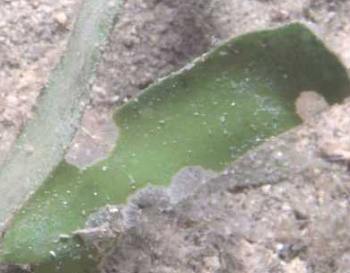Re: Oxynoe olivacea from Turkey
October 5, 2002
From: Kathe R. Jensen
Dear Baki,
Your report on Oxynoe olivacea feeding is very interesting. It seems to me that now you have a "one-in-a-lifetime" opportunity to study interactions between native and immigrant sacoglossans in the Mediterranean. I hope that you have or can get laboratory facilities to keep all 3 species and observe if they show different feeding rates, food preferences, growth rates, or any other interactions. This could be vital information for the people studying Caulerpa taxifolia in the Mediterranean.
I have observed the feeding in Oxynoe olivacea, and it does exactly what you describe - makes these half-circle empty marks along the margins of the blade of C. prolifera. It is difficult to explain in words, but the extrusible part of the oral tube extends around the edge of the blade, and it looks like it "wrings" the part that is emptied to get all the cytoplasm out. The other species of Oxynoe extend the extrusible parts of the oral tube all around a utricle of Caulerpa spp., and this is why they rarely (if ever) feed on C. prolifera. - Bill: C. prolifera is siphonalean like all the other Caulerpa species, but I don't know how the internal trabeculae (strings of cell wall material) are organised in this species.
Best wishes,
Kathe
jensen@ait.ac.th
Jensen, K.R., 2002 (Oct 5) Re: Oxynoe olivacea from Turkey. [Message in] Sea Slug Forum. Australian Museum, Sydney. Available from http://www.seaslugforum.net/find/8117
Dear Kathe,
Why I asked about the structure of Caulerpa prolifera is that in Baki's photo I can clearly see a translucent white tissue remaining in the areas in which the green materal has been eaten. I guess it is either the translucent outer cell wall which has been drained, or sucked dry, of its contents, or it is an internal skeletal structure, like the skeleton of a leaf. If the latter, then the slug would need to 'scrape' off the green plant tissue when feeding, which would be very unusual for a sacoglossan. We need to know the structure of the plant before we can try an interpret how it is feeding.
Cheers,
Bill Rudman
Related messages
-
Re: Unusual sleeping behavior of Oxynoe olivacea
From: Juan Lucas Cervera, January 19, 2004 -
Sleeping aggregations in Oxynoe olivacea
From: Thierry Thibaut, January 19, 2004 -
Unusual sleeping behavior of Oxynoe olivacea
From: Baki Yokes, January 13, 2004 -
Re: Oxynoe olivacea from Turkey
From: Kathe R. Jensen, October 7, 2002 -
Oxynoe olivacea from Turkey
From: Baki Yokes, October 4, 2002
